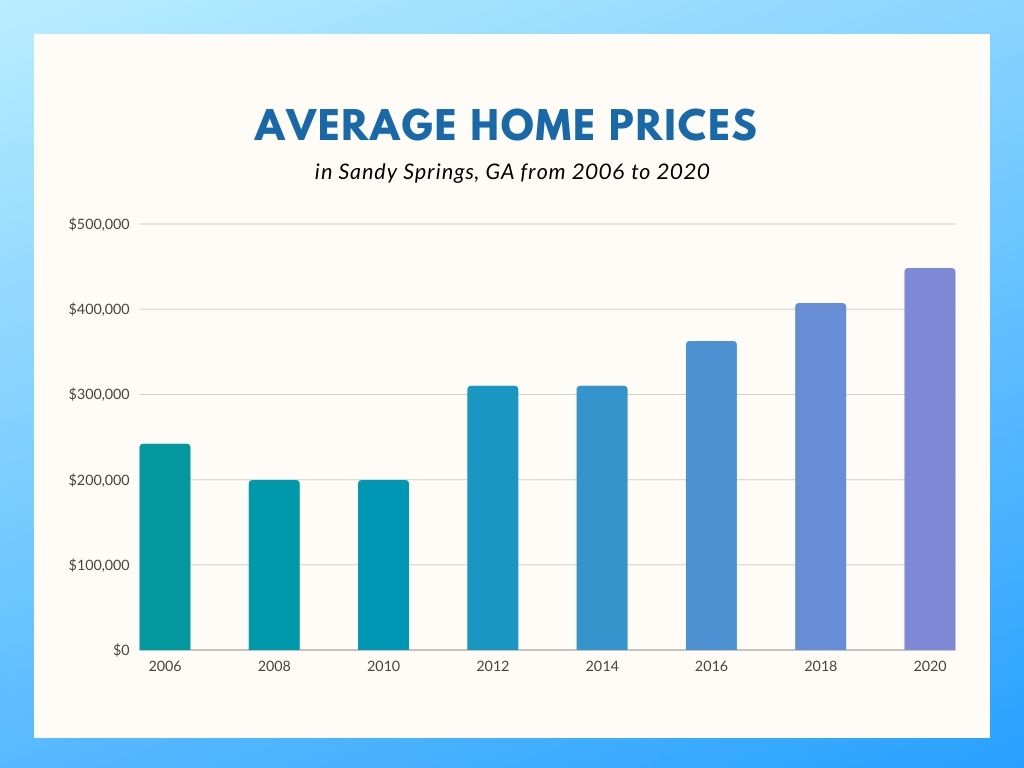Fifteen year old promises of affordability along the Atlanta Beltline have fallen through, proving further the desire of city politicians to ostensibly satiate the masses while receiving checks under the table. The Beltline, initially funded in April 2005 by Mayor Shirley Franklin, promised upwards of 5,600 affordable units along the structure to actively fight against the economic displacement that the city knew such a construction would bring about. Today, less than 700 of those promised units have been built, and the Beltline instead stands as a symbol of Atlanta’s continuously growing gentrification.
New York Mural by Stuart Davis, capturing the rapid growth of the city in the height of the Empire State Building, and those left outside the hustle, unable to keep up with the unforgiving boom of the city.
The more recent development of Sandy Springs, which sits just north of Atlanta, has housing prices that are already classified by the Urban Displacement Project as a mixture between moderate income to exclusive, surpassing their definition of “Advanced Gentrification.” Sandy Springs serves as an example of a location where housing rental and purchase rates have been rising rapidly for years, to the extent that residents of 20+ years are forced to uproot their families and jobs in search of housing within their budget.
Cat-walk by Charles Sheeler. The geometric perfection, pristine colors, and blue sky make the view of scaffolding and general industrial development soothing, however, construction often becomes a hassle to move through in reality, and adding to the hustle of the city. In the same vein, the economic growth of gentrification appears positive on paper, but demonstrates many negative side effects in reality.
Affordable housing, defined in this sense as a range of available housing priced for low, mid, and high income individuals and families, is imperative within the realm of providing personal necessities under the umbrella of universal human rights, and a lack thereof is harmful to the diversity, economy, and future of a city. The city of Sandy Springs is only one of the many rapidly expanding locations that are displacing their long term residents, and more policies have been created in favor of this crisis than in opposition to it.
As housing prices rise to match only those who can pay top dollar throughout the whole of a city, minorities and low-mid income households are displaced. The exclusivity growing throughout the city has been forcing low income families out for years, and has now reached a point where more than a third of the city’s current inhabitants are cost-burdened, or paying over 30% of their income for housing.

Though Sandy Springs is home to a fairly diverse population, many minorities have taken the brunt of the impact, being deprived of adequate access to knowledge about the changes being brought upon their residences. In speaking to members of the community, one young adult revealed that there was a particular apartment complex with a large Hispanic population in the North end of Sandy Springs, which held inhabitants that were unaware of reconstruction plans on the building until the demolition was scheduled concretely. The information was accessible only to those searching for it, and there was no consideration to the language barrier present for many of these families involved. Without active retaliation by both the community and government of the city, the unique and rich culture that has thrived in Sandy Springs will be replaced by large corporations and strictly wealthy residents.
Composition C with Red, Yellow, and Blue by Piet Mondrian is a simple modernist painting with clear and concise divisions between differing shapes and colors, representative of the segregation that gentrification induces.
While the effects of unbounded housing prices on population diversity may be detrimental in themselves, these effects also adversely impact the economy of a city. The introduction of more housing, job opportunities, and revitalization projects such as the Atlanta Beltline have brought a population boom to Sandy Springs, causing an increase in housing demand. This increase in demand has in return brought an opportunity for prices to rise drastically, and they have; average home prices in the city rose from $241,700 in 2006, to a current average of $447,800.

Though a greater amount of money flowing into the economy may look beneficial on paper, a lack of affordable housing is likely to drive away current and new businesses in the area. When individuals are forced to move out of the city due to unsustainable rental rates, they either accept a longer commission time, or are also forced to leave their jobs. Longer commission times have become increasingly common as housing prices have risen in the city, and in some situations, businesses have had to shorten their working hours to accommodate. If employee retainment becomes a consistent problem, businesses are made to spend the average cost of filling a position far too often for the expenditure to be worthwhile, and they will move to a more conducive location. Several companies have begun homeownership initiatives to institute more permanent housing and stop employees from being uprooted, however, this is yet another large cost for a business to take on in response to a lack of affordable housing available in a city. A continuation of increasing prices within the housing market will destroy the city’s economy; having only the wealthiest within city borders would remove all essential jobs paying low to mid income from the equation, leaving no individuals to work in grocery stores, restaurants, and even many emergency service positions. Though a jump in housing prices may initially signify economic growth, it will become virulent if left in ignorance to run rampant.

Real change for those drowning within rising housing costs must start from education in the community. Policy implementation is within direct authority of those in power, but the introduction of wealthy individuals and large corporations is rather enticing for policymakers, as monetary support is often valued above all else. Without the voice of the community exercising their own rights to have a say in the matters of their own city, economically complicated necessities like this will not come to fruition. It is imperative that each and every member of a community have access to knowledge of local current events, regardless of whether they are a homeowner or renter, and should be provided with the same opportunity to attend and speak at public events such as city hall meetings
With a combination of displacement, reduced racial and socioeconomic diversity, and economic upheaval, what will the future of Sandy Springs look like without change? It will become an empty husk, rather than the vibrant city it is today. Long term inhabitants will be largely outnumbered by those only able to afford a short stay, unique and small businesses will be replaced by large corporations, and much like the introduction of the Atlanta Beltline, the city will come to represent vigorous gentrification within the Atlanta area.

YES! The gentrification in Atlanta is so pervasive and is given a “get out of jail” when it comes to the negatives of the whole process. Like you said, it disproportionately affects communities of color. Not to mention, Atlanta has one of the largest income desparities in the U.S. Many people forget about that especially at Tech. People coming to live in the city only see the affluent, gentrified areas while overlooking other areas. It is very easy to get distracted by the shiny new buildings and tourist attractions. I like how you talked about Sandy Springs specifically. When I think about gentrification in ATL, I personally always think about Buckhead. My mom will talk about Buckhead when she was in college and it is nothing like how it is now. Buckhead is now an extremely affluent area, completely disregarding the families and people who were kicked out because of gentrification. I really liked the second piece of art you used. I haven’t seen it before but it is so cool to see the parallels between the art and gentrification. Both definitely give cover-up operation vibes. It seems too picture-perfect.
I found reading this very interesting, as I also did my project on gentrification. While you focused on Sandy Springs, an area that has been gentrified already, I focused on a couple of neighborhoods that are very early on in the process of gentrification (English Avenue and Vine City). As a resident of English Avenue, reading this was somewhat discouraging, because the government is making many of the same promises that they made in Sandy Springs, especially relating to affordable housing. It’s a bit scary to see that the government has made very similar promises in the past and not kept them. We are just beginning to see our property taxes rise because a new connector trail to the beltline is being put into the neighborhood, so I hope that the government actually stays true to what it is saying and provides affordable housing so that the people in the neighborhood can stay. I found your economic argument very interesting as well, because most of the time you hear about gentrification as negatively affecting the poor, but with the benefit of improving the economy. I liked that you pointed out that removing low-income residents can lead to less people to do some very necessary jobs. I enjoyed your first image, and really feel like it captures the feeling of gentrification, with people on the outside looking into the busy city. I also thought that the connection between your fourth image and gentrification was creative, but valid. Your other images were nicely placed to provide statistics about your argument to increase credibility. Your education argument was spot on, and points out how flawed some parts of our education system are. Schools are largely funded by the property taxes of the area they service, so the poor areas that really need great schools rarely have the funding for them. It is sad that as an area grows in value, the poorer people in it are often forced out, just as education in the area may be improving. Overall, I really enjoyed reading your essay, and it made me think about certain parts of gentrification in slightly different ways.